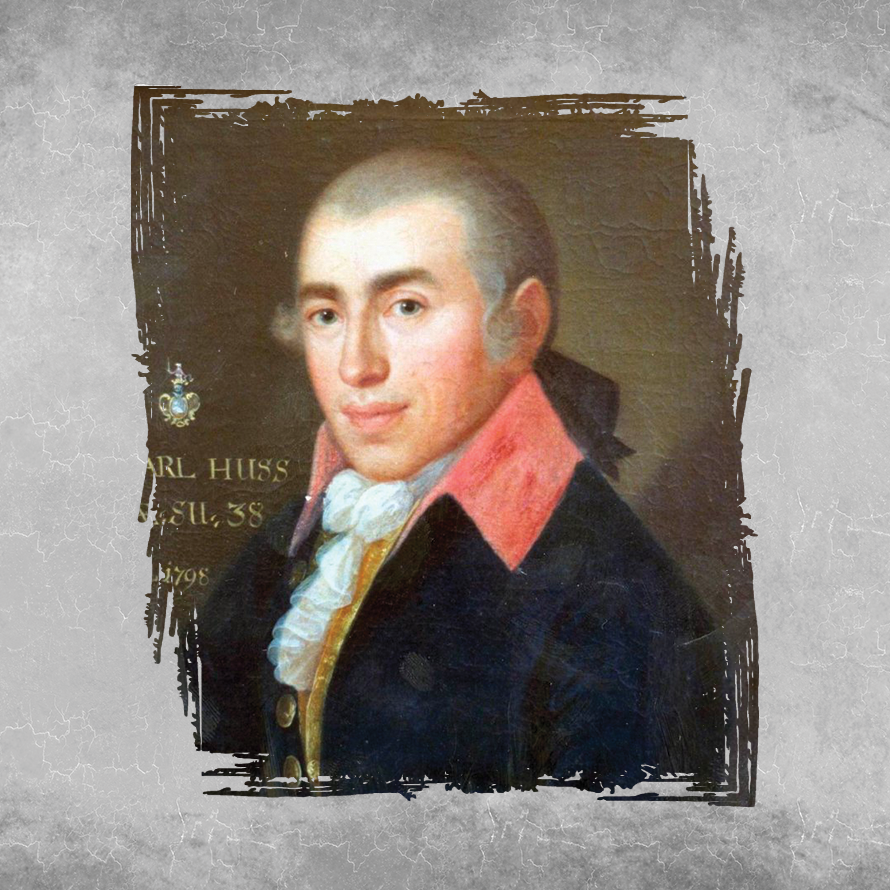PERSONALITIES
KARL HUSS
BACK TO LIST

Karl Huss
Birthdate: January 3, 1761
Date of death: November 19, 1838
The son of the executioner in the town of Most Pavel Huss. The father´s effort to have his son study the grammar school was met with hatred of the local citizens and the prejudices of that time. Schoolmates mockery and bullying by teachers have forced the talented eleven years old Huss to leave the school. Huss bore the sign of a ´dishonourable´ origin and underprivileged member of the civic community his entire life. Being recognized and honoured in his old age was not because of a change of the opinions at that time but he has enforced it by his diligence, education, life attitude imbued by big moral pathos and civic pride.
After escaping from the school, Huss was taught by private teachers and he decided for the occupation of an executioner after the pattern of his father. When he was 15 years old, he did his first execution, as an eighteen years old executioner master he leaves to get new experiences abroad. In summer 1779 he comes to Cheb where his uncle was the town executioner. Huss stays here over year and instead of his over-aged uncle does three executions in which he proves his handiness and mastery.
In April 1781, Huss comes back to Cheb permanently, taking over the vacancy of town executioner which he was performing other 47 years. Because of his medical knowledge he became a sought-after miraculous healer soon and was called also to the local burgher families. He met the daughter of the bakery master Eberl whom he married after an adventurous kidnapping from her parent´s home (despite permanent resistance of her parents). As describes Huss in his own biography, he and his wife, the couple Sofie and Karl, lived only for themselves and in a seclusion because ´dignity did not belong to their personalities´. This segregation from the society was symbolized also by the location of the Cheb executioner´s home at the town walls. Yet, in the beginning of the 19th century, there was not any more significant visitor of Cheb who would not like to visit the small half-timbered house next to the Mill Gate under the castle.
Huss took advantage of the social isolation for study and self-education. He starts to build a numismatic collection out of the old coins he was getting for treatment, as an autodidact he is concerned with mineralogy, supplying the top European cabinets and private collectors with selected minerals. The professors of poetry and history from the Cheb grammar school A. Grassold and A. Libscher initiate Huss into the basics of history,
Huss collects documents to the town history and saves endangered antiquities. The Cheb executioner´s house changes into a small museum successively. The reputation of a significant collector and educated executioner spreads quickly due to the spa guests, the Berlin newspaper write about the Cheb ´noteworthiness´, distinguished scholars start a correspondence with Huss and viewing his collections belongs to the social program of the spa nobs. Therefore no wonder that also the biggest German poet J.W. Goethe, going often to the spa, became a regular visitor of this first Cheb museum.
However, Huss was not only a collector. His versatile interests and skills brought him soon also to the research activity in regional history and ethnography. In the years of 1797-1828, he writes an extensive, four-volume chronicle of the town of Cheb which represents a precious testimony especially of the time recorded by Huss as the contemporary. In addition to the factual value, the Huss´s chronicle is an authentic, personally biased and critical testimony of the life of the town. Because of Huss´s concern with the truth arises also his writing O pověrách (On superstitions) systematically arranging and explaining various demonstrations of superstitiousness as he got to know personally when travelling in the Cheb region. Huss irreconcilably reveals different charlatans, quacks and whisperers. From the implicit meaning of the entire writing distinguishing between an accurate help and deception it is always obvious that he defends himself since as a healer he was constantly attacked by official pharmacists and wounds healers. Together with an essay about the Cheb region, this manuscript belongs indisputably to the founding ethnographical works from the Cheb area.
Huss was a capable draughtsman at the same time. His colorized illustrations of the chronicle, portrayals of buildings and sights from the Cheb´ s sights manuscript as well as his drawings from the list of Cheb coats of arms are a time evidence of unwanted glamour and invaluable iconographic source.
Frequent Huss´s attempts on meditative essays and poetry are less known. And the greatness and contradictoriness of this remarkable personality, the last Cheb executioner and a miraculous healer and at the same time the first collector and museum worker, chronicler and draughtsman, essayist and poet, are most recognizable in them. The writing part of his heritage gives us an insight on Huss as a typical figure of the contradictory time at the break of 18th and 19th century. A passionate moralist, immersed in deep religiosity is at the same time a critically enlightened observer of his time.
In 1824, Sofie dies and the aging Huss lives lonely in his executioner´s house another three years. He wants to preserve his collections and therefore he offers them to the town for purchase. The Cheb Council, lead by the burgomaster Totzauer in the spirit of rational modernisation of the town is not interested in the Huss´s collection. Huss addresses Prince Metternich through the municipal worker J. S. Grüner whom he had known from joint meetings with Goethe and who belongs also to the first researchers of the Cheb region geography and history. He agrees to take over the collection and a contract according to which Huss gets a life annuity of 300 golden coins, free housing and the position of chateau collections custodian, is signed.
I May 1828, Huss transports all gathered collections to the history of the town of Cheb to Kynžvart, using four trucks loaded with 21 boxes. It takes him three months to install his collections and he becomes the steward of one of the first chateau museums. He was able to continue in this fulfilled life goal consisting in collecting and beautiful sciences another ten years of life. Huss dies in his 78 years. His collection and written inheritance have remained permanently in the Kynžvart chateau.
Show more


 OFFICIAL WEBSITE OF CITY CHEB
OFFICIAL WEBSITE OF CITY CHEB
 TOURIST INFOCENTRE
TOURIST INFOCENTRE
 HISTORICAL CHEB FOUNDATION
HISTORICAL CHEB FOUNDATION

 CULTURAL CENTER SVOBODA
CULTURAL CENTER SVOBODA
 WEST CZECH THEATER CHEB
WEST CZECH THEATER CHEB
 CITY LIBRARY IN CHEB
CITY LIBRARY IN CHEB

